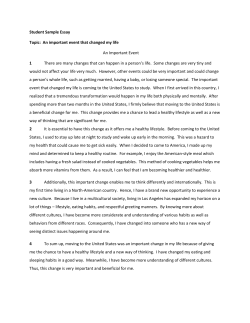
Handout
Developing and Implementing a Healthy Lifestyle Policy Goal: Participants will have an opportunity to understand the process and tools used to develop and implement a Healthy Lifestyle Policy. Outcomes: Participants will be able to… - Discuss challenges in the process - Identify process to create a policy - Utilize the NAP-SAC tool to assess nutrition and physical activity in their program. - Presented by Steve Erwin Small group activity Discuss: What concerns you about the health of children in your programs? What have you done to support healthy lifestyles for your children in your programs. Do you discuss healthy lifestyle issues with families? Do you think this is any of your concern as a provider? Over the past three decades, childhood obesity rates in America have tripled. Nearly one in three children in America are overweight or obese. Higher in African American and Hispanic communities, where nearly 40% of the children are overweight or obese. If we don't solve this problem, one third of all children born in 2000 or later will suffer from diabetes at some point in their lives. Others will face chronic obesity-related health problems like heart disease, high blood pressure, cancer, and asthma. http://www.letsmove.gov/learn-facts/epidemic-childhood-obesity One more reason Decide if your program should make “healthy lifestyle part of your curriculum. Communicate with parents about the decision and invite them to be part of process. Assess your program’s current ability in supporting healthy lifestyle. Assess staff’s attitudes and cultural beliefs about a healthy lifestyle. Develop a policy with staff and parents. Develop and implement strategies for healthy lifestyle. Small group activity Discuss: What did you eat growing up? How did adults get you to try new things to eat? What has changed about what and how you eat now? How do you help children to try new things to eat? What if someone told you that you could not eat what you wanted to? Small Group – Each member take a page of the assessment and review. If time permits exchange pages. Other Considerations Screen time – NAEYC Position Statement: Key Messages • When used intentionally and appropriately, technology and interactive media are effective tools to support learning and development. • Intentional use requires early childhood teachers and administrators to have information and resources regarding the nature of these tools and the implications of their use with children. • Limitations on the use of technology and media are important. • Special considerations must be given to the use of technology with infants and toddlers. • Attention to digital citizenship and equitable access is essential. • Ongoing research and professional development are needed. Other Considerations Ellyn Satter – Division of Responsibility in Feeding http://ellynsatterinstitute.org/dor/divisionofresponsibilityinfeeding.php Gardens – Farm to School – Organic http://www.agrarianadventure.org/farm-to-school/ http://www.farmtopreschool.org/preschoolgardens.html Vaccines for Your Children http://www.cdc.gov/vaccines/parents/ Small group activity- Discuss what would an action plan need to include to begin the discussion of Healthy Lifestyle Policy in your program. Consider: - Who would you invite to begin this process? - How or would use the NAP-SAC? - How would this impact your food program? - What considerations would you address (example: cultural, physical activity, screen time etc.)? - Would you develop a philosophy statement? - Outline a scope of work? - If you have a plan in place share your experience. Thank you – Steve Erwin
© Copyright 2025





















